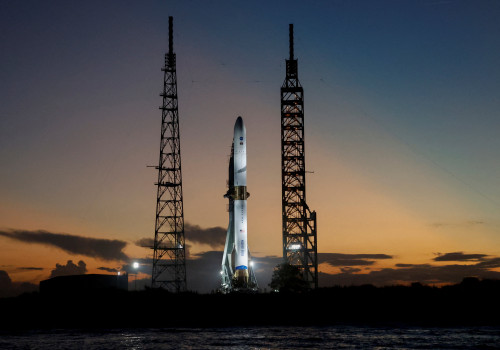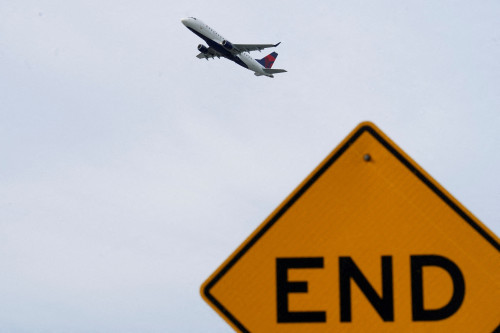By Joey Roulette and Akash Sriram
WASHINGTON (Reuters) -SpaceX’s workhorse Falcon 9 rocket was grounded by the U.S. Federal Aviation Administration (FAA) on Friday after one broke apart in space and doomed its payload of Starlink satellites, the first failure in more than seven years of a rocket relied upon by the global space industry.
Roughly an hour after Falcon 9 lifted off from the Vandenberg Space Force Base in California on Thursday night, the rocket’s second stage failed to reignite and deployed its 20 Starlink satellites on a shallow orbital path where they will soon reenter and burn up in Earth’s atmosphere.
The attempt to reignite the engine “resulted in an engine RUD for reasons currently unknown,” SpaceX CEO Elon Musk wrote early on Friday on his social media platform X, using an industry acronym for Rapid Unscheduled Disassembly that usually means explosion.
The Falcon 9 will be grounded until SpaceX investigates the cause of the failure, fixes the rocket and receives the agency’s approval, the FAA said in a statement. That process could take several weeks or months, depending on the complexity of the failure and SpaceX’s plan to fix it.
The botched mission of the world’s most active rocket breaks a success streak of more than 300 straight missions during which SpaceX has maintained its dominance of the launch industry. Many countries and space companies rely on privately owned SpaceX, valued at roughly $200 billion, to send their satellites and astronauts into space.
Musk said SpaceX was updating the software of the Starlink satellites to force their on-board thrusters to fire harder than usual to avoid a fiery atmospheric re-entry.
“Unlike a Star Trek episode, this will probably not work, but it’s worth a shot,” Musk said.
The satellites’ altitude is so shallow that Earth’s gravity is pulling them 3 miles (5 km) closer toward the atmosphere with each orbit, SpaceX later said, confirming they would inevitably “re-enter Earth’s atmosphere and fully demise.”
NASA in a statement after Thursday’s mishap said it monitors all of SpaceX’s Falcon 9 missions.
“SpaceX has been forthcoming with information and is including NASA in the company’s ongoing anomaly investigation to understand the issue and path forward,” a spokesperson for the space agency said.
SpaceX said the second stage’s failure occurred after engineers detected a leak of liquid oxygen, a propellant.
The mishap occurred on Falcon 9’s 354th mission. It was the first Falcon 9 failure since 2016, when a rocket exploded on a launch pad in Florida and destroyed its customer payload, an Israeli communications satellite.
“We knew this incredible run had to come to an end at some point,” Tom Mueller, SpaceX’s former vice president of propulsion who designed Falcon 9’s engines, replied to Musk on X. “… The team will fix the problem and start the cycle again.”
IMPACT ON SPACEX’S LAUNCH BUSINESS
The failure will likely stymie SpaceX’s intensifying launch pace for the Falcon 9. The rocket’s 96 launches last year were its most to date and exceeded the annual launch total in any country. By comparison, China, an increasingly competitive space rival to the U.S., launched 67 missions to space in 2023 using various rockets.
“It is extremely rare for Falcon to fail. They have a much better rate than almost any other rocket developed in terms of the success of their mission,” said Will Whitehorn, chair of the venture capital firm Seraphim Space Investment Trust.
Although Thursday night’s Falcon 9 flight was an in-house mission, the rocket’s grounding is likely to impact the company’s upcoming customer missions.
Falcon 9 is the only U.S. rocket capable of sending NASA crews to the International Space Station. The U.S. space agency was expecting to launch its next astronaut mission in August, with SpaceX’s Crew Dragon astronaut capsule launching atop the rocket.
NASA did not immediately respond to a request for comment. It has been trying to help fix unrelated problems with Boeing’s Starliner spacecraft, which is in the midst of a high-stakes test mission to prove it can become NASA’s second astronaut ride to orbit alongside Crew Dragon.
SpaceX was poised to launch as early as July 31 its Polaris Dawn Crew Dragon mission sending four private astronauts into orbit for a few days to conduct the first commercial spacewalk using the company’s newly designed spacesuits.
Jared Isaacman, head of the Polaris program and a crew member on the mission, said he expects SpaceX to quickly recover from the failure.
“As for Polaris Dawn, we will fly whenever SpaceX is ready and with complete confidence in the rocket, spaceship and operations,” Isaacman wrote on X.
Musk replied that “we will investigate the issue and look for any other potential near-misses.”
SpaceX has launched about 7,000 Starlink satellites of various designs into space since 2018 for its global broadband internet network. Industry analysts have said the satellites on Thursday’s mission could be worth at least $10 million combined.
(Reporting by Joey Roulette; additional reporting by Kanjyik Ghosh; Editing by Will Dunham, Barbara Lewis and David Holmes)




